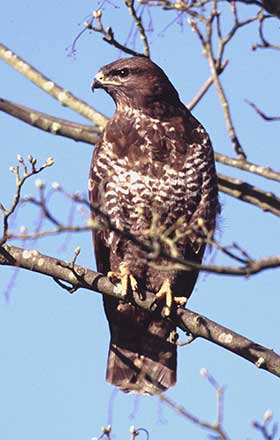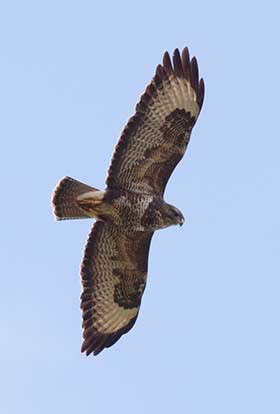Buzzard (Buteo buteo)
When: All year round
How many: Relatively abundant / widespread

The buzzard is probably the most frequently seen New Forest bird of prey, and certainly the most frequently heard. Look out for buzzards high in the sky, almost out of sight, soaring on the thermals, wings outstretched, sometimes in loose groups of 10, or more. And listen for buzzard calls, loud, repeated mews raining down on earth.
Buzzards are large, compact birds of prey with hooked bills, broad wings, short necks and short tails. Buzzard colour and plumage patterns vary, but usually feature substantial areas of dark brown and variable amounts of creamy-white. Some buzzards, maybe many, pair for life, and hold territory throughout the year.
Buzzard nests are large, bulky structures up to 1 metre (3 feet) across when new, but, as they’re often re-used, they expand with every passing year. They are made of sticks, heather and whatever other material is available, and are usually sited high up, often close to the main trunk of an oak, beech or conifer.
Buzzards normally lay two to three eggs in early April, incubation lasts for around 34 days, the fledgling period is 50-55 days, and the youngsters are dependent on their parents for up to a further 40-55 days.
Newly fledged young buzzards often perch in woodland-edge trees, overlooking open ground where flying experience can be gained without too much fear of crashing into obstacles. They betray their presence with raucous, repetitive calls that eventually develop into high-pitched versions of the adult mew.
Dispersal follows, after which the young birds face the uphill, often insurmountably difficult, task of establishing their own territories.
Buzzard numbers have varied considerably over the last 200 years.
Persecuted by gamekeepers, farmers, sportsmen and egg collectors, buzzards were extinct in many English counties by the 19th century, but some remained in the New Forest where they were tolerated by at least some of the local keepers.
Following the start of the First World War, the buzzard population nationally started to recover as gamekeepers went off to fight, and continued until myxomatosis devastated the rabbit population in the 1950s, thus depriving buzzards of a major food source.
Organochlorine pesticides were also introduced at around the same time, for use as seed dressings, and in sheep dips where they provided protection against parasites. These pesticides, particularly in areas where the buzzards fed on sheep carrion, indirectly poisoned the birds, with all too disastrous consequences.
But in the New Forest, buzzards were largely insulated from the effects of both. Rabbit numbers had for many years been low, whilst sheep carrion is rarely available.

In fact, New Forest buzzards survive by catching other birds, grey squirrels and whatever small rodents can be found, and supplement their diet, rather incongruously, with earthworms - in wet weather, they can often be seen on favoured lawns standing patiently, waiting for an earthworm to appear, encouraged to the surface by the damp.
From the 1920s until the early 1970s, local buzzard numbers seem to have remained broadly constant at the relatively low level of around 35 to 40 pairs. However, from 1969 until the mid-1980s, commoners’ stock, primarily ponies, were allowed to graze the woodland inclosures. Ground level vegetation was consequently greatly reduced, small mammal numbers fell, and so, too, did buzzard numbers. Down, in fact, by around 50%.
But now, with commoners’ stock again largely excluded from the inclosures, the buzzard is doing well. In fact, following a remarkably heavy 2004 beech mast, acorn and seed crop, 2005 was a tremendous year for these majestic creatures. Prey species prospered, and so did buzzards. 80 occupied territories were recorded by researchers, and 65 successful nests found in which were reared 112 young. Such were their numbers that at least one youngster became almost urbanised, feeding in Lyndhurst gardens whenever suitable tit-bits were put out.
Unfortunately, however, the 2005 beech mast and acorn crop largely failed, and so did the majority of 2006 Buzzard breeding attempts, with only 5 occupied nests found.
But such are the vagaries of nature.
References:
The Shell Guide to the Birds of Britain and Ireland: James Ferguson-Lees, Ian Willis, and J.T.R. Sharrock.
The New Forest: Its History and Scenery: John R. Wise.
The Museum of English Rural Life:
http://www.reading.ac.uk/Instits/im/interface/public/countryside/
ruralind/ruralind_oak_bark_stripping.html#
The Historical Atlas of Breeding Birds in Britain and Ireland, 1875-1900: Simon Holloway
The Buzzard: Colin R. Tubbs.
The New Forest – A Natural History: Colin R. Tubbs
The Birds of the Western Palearctic: Stanley Cramp, et al.
More links
Other related links
Search this site

Sadly, 58 animals were killed - 35 ponies, 13 cows, 8 donkeys and 2 sheep, whilst a further 32 were injured - 3 pigs, 9 donkeys, 11 cows and 9 ponies.
(Forty-three accidents occurred in daylight, 15 at twilight and 101 in the dark. Twenty-seven accidents were not reported by the driver involved).
Here's just one horrific example - Three donkeys killed in collision with van at notorious New Forest blackspot (Advertiser and Times)

